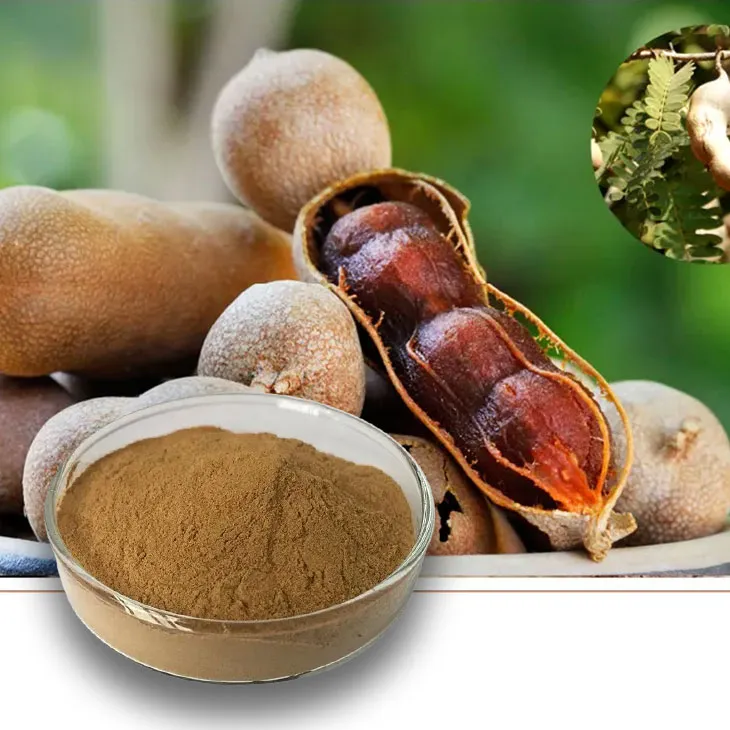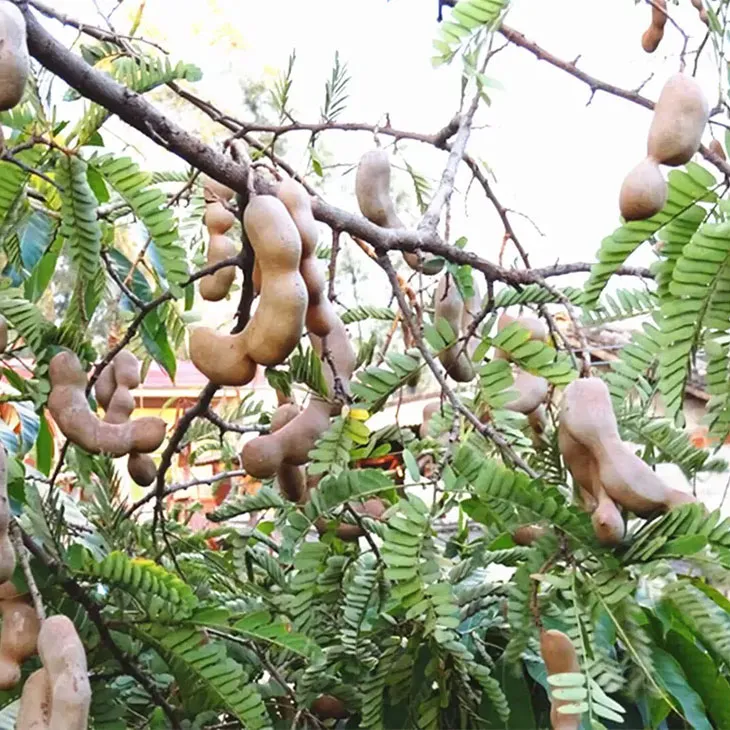- 0086-571-85302990
- sales@greenskybio.com
Tamarind extract powder: China vs. the United States.
2024-11-30

1. Introduction
Tamarind extract powder is a product with a wide range of applications in the food, pharmaceutical, and cosmetic industries. This article aims to compare the production, quality standards, and applications of Tamarind extract powder in China and the United States. By exploring the differences in raw material sources, extraction techniques, and regulatory environments, a comprehensive understanding of the similarities and differences between the two countries in this regard can be achieved.

2. Raw Material Sources
2.1 China
In China, tamarind is mainly sourced from domestic cultivation and some imports. China has suitable regions for tamarind growth, especially in some southern areas with warm and humid climates. Domestic tamarind cultivation provides a certain amount of raw materials for the production of Tamarind extract powder. Additionally, imports from neighboring countries may also supplement the raw material supply. The Chinese tamarind varieties may have their own characteristics in terms of taste and chemical composition, which can influence the quality of the extract powder.
2.2 United States
The United States also has its own sources of tamarind. Some tamarind is grown domestically in suitable regions, such as parts of Florida and Hawaii. However, the United States also relies on significant imports from various countries, especially those with large-scale tamarind production. The raw materials sourced in the United States may vary in quality depending on the origin, with some high - quality tamarind being imported from regions known for their excellent tamarind cultivation practices.

3. Extraction Techniques
3.1 China
- In China, traditional extraction methods are still widely used in some small - scale productions. These methods may include solvent extraction, where solvents such as water or ethanol are used to extract the active components from tamarind.
- Modern extraction techniques are also being increasingly adopted in larger - scale industrial production. For example, supercritical fluid extraction (SFE) is being explored. Supercritical fluid extraction has the advantage of being able to extract target components with high purity and efficiency while minimizing solvent residue. This technique is beneficial for obtaining high - quality tamarind extract powder.
- Another extraction method used in China is microwave - assisted extraction. This method can accelerate the extraction process by using microwave energy, which can save time and energy in the production of tamarind extract powder.
3.2 United States
- The United States has a strong emphasis on advanced extraction technologies. Enzyme - assisted extraction is one of the techniques used. Enzymes can break down the cell walls of tamarind more effectively, facilitating the release of active ingredients. This method can improve the yield and quality of the extract.
- Similar to China, the United States also utilizes supercritical fluid extraction in some large - scale production facilities. The application of this technique in the United States is often accompanied by strict quality control measures to ensure the consistency and high quality of the tamarind extract powder produced.
- There is also research and application of ultrasonic - assisted extraction in the United States. Ultrasonic waves can create cavitation effects in the extraction solvent, enhancing the mass transfer process and thus improving the extraction efficiency.

4. Quality Standards
4.1 China
- In China, quality standards for tamarind extract powder are mainly set by national and industry standards. These standards cover aspects such as the purity of the extract, the content of active ingredients, and the limits of heavy metals and other contaminants.
- For example, the content of key components such as tartaric acid in tamarind extract powder is strictly regulated. Chinese manufacturers are required to ensure that their products meet these standards through quality control measures during the production process.
- The Chinese regulatory authorities also conduct regular inspections of tamarind extract powder products to ensure that they comply with the established quality standards. Non - compliant products are not allowed to enter the market.
4.2 United States
- The United States has its own quality control system for tamarind extract powder. The Food and Drug Administration (FDA) plays a crucial role in setting and enforcing quality standards. The FDA regulations cover aspects such as the safety of the extract, the accuracy of labeling, and the compliance with good manufacturing practices (GMP).
- For instance, in terms of food - grade tamarind extract powder, the FDA has strict requirements on the allowable levels of additives and preservatives. The United States also has industry - led quality initiatives that encourage manufacturers to adhere to higher - than - minimum quality standards to enhance the competitiveness of their products in the market.
- Quality control in the United States often involves third - party testing laboratories to ensure the objectivity and reliability of the test results. These laboratories are accredited and follow strict testing procedures.

5. Applications
5.1 China
- In the food industry, tamarind extract powder is widely used in the production of candies, beverages, and seasonings in China. For example, in some traditional Chinese candies, tamarind extract powder is added to provide a unique sour - sweet flavor.
- In the pharmaceutical field, tamarind extract powder has certain medicinal properties. It may be used in the formulation of some traditional Chinese medicine preparations for treating digestive problems or as an ingredient in some health - care products.
- In the cosmetic industry, tamarind extract powder can be used in skin - care products. Its antioxidant and moisturizing properties make it suitable for products such as facial creams and lotions.
5.2 United States
- In the United States, the food industry is a major consumer of tamarind extract powder. It is used in a variety of processed foods, including sauces, dressings, and snacks. The unique flavor of tamarind adds a distinct taste to these products.
- In the pharmaceutical area, tamarind extract powder is being studied for its potential in drug development. Some research is focused on its anti - inflammatory and anti - microbial properties, which may lead to the development of new drugs.
- In the cosmetic and personal care industries, tamarind extract powder is used in hair - care products as well as skin - care products. It can help improve the texture and health of hair and skin.
6. Regulatory Environments
6.1 China
- In China, the production and sale of tamarind extract powder are regulated by multiple government agencies. The State Administration for Market Regulation (SAMR) oversees the overall market supervision, including product quality, safety, and labeling requirements.
- The Ministry of Agriculture and Rural Affairs may also be involved in aspects related to the raw material sources, especially if there are issues regarding agricultural cultivation and imports of tamarind.
- Manufacturers are required to obtain relevant production licenses and comply with strict regulatory requirements at each stage of production, from raw material procurement to final product packaging.
6.2 United States
- The United States has a complex regulatory environment for tamarind extract powder. As mentioned earlier, the FDA is the main regulatory body responsible for ensuring the safety and quality of food - and drug - related products containing tamarind extract powder.
- The United States Department of Agriculture (USDA) may also play a role in certain aspects, especially if the tamarind is related to agricultural imports or if there are issues regarding the use of tamarind in agricultural - based products.
- Manufacturers in the United States need to comply with a variety of federal and state regulations, which can be a significant challenge in terms of ensuring compliance and market access.
7. Conclusion
In conclusion, both China and the United States have their own characteristics in the production, quality standards, applications, and regulatory environments of tamarind extract powder. While there are similarities in some aspects, such as the use of advanced extraction techniques and the wide application in the food and cosmetic industries, there are also differences in areas such as raw material sources and regulatory details. Understanding these differences can help promote international trade, cooperation, and the improvement of product quality in the field of tamarind extract powder.
FAQ:
What are the main raw material sources for tamarind extract powder in China?
In China, tamarind extract powder is often sourced from locally grown tamarind trees. These tamarinds are carefully selected based on their maturity and quality. Some are from large - scale plantations in certain regions where the climate is suitable for tamarind growth, such as in some tropical and subtropical areas.
How does the extraction technique of tamarind extract powder differ in the United States?
In the United States, the extraction technique may involve more advanced technological equipment. For example, they may use more precise and automated extraction machines that can control parameters like temperature, pressure, and extraction time more accurately. This can result in a more consistent quality of the tamarind extract powder. Also, there may be a greater emphasis on using environmentally friendly solvents in the extraction process.
What are the quality standards for tamarind extract powder in China?
In China, the quality standards for tamarind extract powder typically cover aspects such as purity, microbial limits, and the content of active ingredients. There are specific regulations regarding the maximum allowable levels of contaminants like heavy metals. The powder should also meet certain solubility and taste requirements. Quality control measures are in place throughout the production process to ensure that the final product adheres to these standards.
How is the regulatory environment for tamarind extract powder different in the United States?
In the United States, the regulatory environment for tamarind extract powder is overseen by various agencies. The Food and Drug Administration (FDA) plays a major role. There are strict regulations regarding its use in food and dietary supplements. For example, any claims made about its health benefits need to be supported by scientific evidence. The production facilities also need to meet certain Good Manufacturing Practice (GMP) standards to ensure the safety and quality of the product.
What are the common applications of tamarind extract powder in both countries?
In both China and the United States, tamarind extract powder has applications in the food industry. It is used as a flavoring agent in products like candies, beverages, and sauces due to its unique sour - sweet taste. In the cosmetic industry, it can be used in skincare products for its antioxidant properties. Additionally, in some traditional medicine practices in both countries, it may be used for certain health - related purposes, although the extent and specific uses may vary.
Related literature
- Tamarind: Botany, Production and Uses"
- "Quality Control of Botanical Extracts: A Global Perspective"
- "The Role of Tamarind in the Food and Cosmetic Industries"
- ▶ Hesperidin
- ▶ citrus bioflavonoids
- ▶ plant extract
- ▶ lycopene
- ▶ Diosmin
- ▶ Grape seed extract
- ▶ Sea buckthorn Juice Powder
- ▶ Beetroot powder
- ▶ Hops Extract
- ▶ Artichoke Extract
- ▶ Reishi mushroom extract
- ▶ Astaxanthin
- ▶ Green Tea Extract
- ▶ Curcumin Extract
- ▶ Horse Chestnut Extract
- ▶ Other Problems
- ▶ Boswellia Serrata Extract
- ▶ Resveratrol Extract
- ▶ Marigold Extract
- ▶ Grape Leaf Extract
- ▶ blog3
- ▶ blog4
-
The best artichoke leaf extract from nature.
2024-11-30
-
Optimal Bioavailability of Green Tea Extract
2024-11-30
-
The best lemon extract on the market.
2024-11-30
-
Active ingredients in kelp extract powder.
2024-11-30
-
How to make powder from hawthorn extract?
2024-11-30
-
Standard - process Vitamin B9.
2024-11-30
-
The best hop extracts on the market.
2024-11-30
-
Wholesale Pomegranate Extract Suppliers.
2024-11-30
-
Nutmeg Extract
2024-11-30
-
Hesperidin
2024-11-30
-
Marigold Extract
2024-11-30
-
Hawthorn powder
2024-11-30
-
Sophora Flavescens Root Extract
2024-11-30
-
Mango flavored powder
2024-11-30
-
Mulberry Extract
2024-11-30
-
Tamarind extract powder
2024-11-30
-
Soy Extract
2024-11-30
-
Red Vine Extract
2024-11-30




















